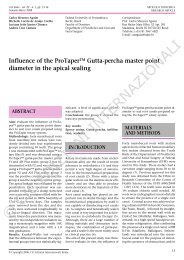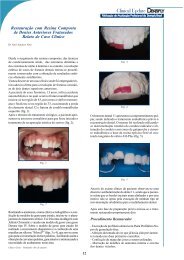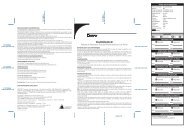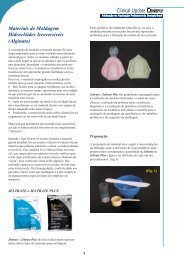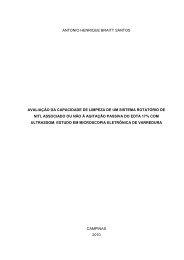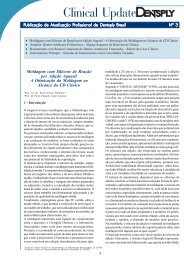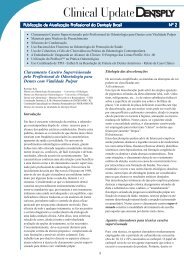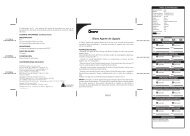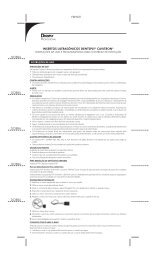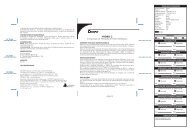You also want an ePaper? Increase the reach of your titles
YUMPU automatically turns print PDFs into web optimized ePapers that Google loves.
Manhart/Trumm<br />
Table 1 Experimental groups and materials used<br />
Group Adhesive Solvent type of Composite<br />
adhesive<br />
G1 XP Bond (<strong>Dentsply</strong> t-butanol Ceram-X Mono (M2)<br />
DeTrey; Konstanz, Germany<br />
(<strong>Dentsply</strong> DeTrey)<br />
G2 Syntac Classic Primer: acetone-water Tetric EvoCeram (A2)<br />
(Ivoclar Vivadent; Adhesive: water (Ivoclar Vivadent)<br />
Schaan, Lichtenstein Heliobond: -<br />
G3 Scotchbond 1 XT Ethanol-water Z250 (A2)<br />
(3M ESPE; Seefeld, Germany) (3M ESPE)<br />
G4 Prime & Bond NT (<strong>Dentsply</strong> Acetone Ceram-X Mono (M2)<br />
DeTrey; Konstanz, Germany<br />
(<strong>Dentsply</strong> DeTrey)<br />
G5 Optibond Solo Plus (Kerr-Hawe; Ethanol Ceram-X Mono (M2)<br />
Bioggio, Switzerland<br />
pumice, standardized Class II inlay cavities (MOD) were prepared,<br />
with one proximal box limited within enamel (1 to 1.5<br />
mm above the cementoenamel junction) and one proximal<br />
box extending into dentin (1 to 1.5 mm below the cementoenamel<br />
junction) (Fig 1). The cavities were 4.0 mm in width<br />
and 3 to 3.5 mm in depth at the occlusal isthmus and 5.0<br />
mm in width at the proximal boxes. The depth of the proximal<br />
boxes in the direction of the axial pulpal walls was 1.5<br />
mm. To achieve divergence angles between opposing walls<br />
of 10 to 12 degrees, cavities were prepared using coarse diamond<br />
burs with a slight taper (855.314, Komet; Lemgo,<br />
Germany) in a high-speed dental handpiece with copious water<br />
spray. Fine grained diamond burs of the same shape<br />
(8855.314, Komet) were used for finishing the preparations.<br />
The internal point and line angles were rounded and enamel<br />
margins were not beveled but prepared in butt-joint configuration.<br />
11 After visual inspection of the cavities for imperfect<br />
finish lines, the 40 prepared teeth were randomly assigned<br />
to 5 experimental groups with 8 teeth each (Table 1),<br />
corresponding to the different restorative techniques. Manufacturers'<br />
instructions for each material were strictly followed.<br />
For the direct composite restorations, all enamel and<br />
dentin surfaces of the cavities were conditioned with 36%<br />
phosphoric acid gel (DeTrey Conditioner 36, <strong>Dentsply</strong> De-<br />
Trey; Konstanz, Germany), starting acid application on enamel,<br />
leaving undisturbed for 15 s, then covering the dentinal<br />
preparation surfaces for an additional 15 s (total-etch technique).<br />
After thoroughly rinsing with water, the cavities were<br />
then gently dried with oil-free compressed air, taking care to<br />
avoid desiccation of the tooth substrate (moist bonding technique).<br />
Following the application and light curing of the adhesive<br />
systems, the cavities were restored with composite<br />
resin (Table 1) using a horizontal and oblique layering technique<br />
with 5 increments in the dentin-limited proximal box<br />
and 4 increments in the enamel-limited box (Fig 1). Each increment<br />
with a maximum thickness of 2 mm was light cured<br />
individually with a LED curing unit (SmartLite PS, <strong>Dentsply</strong><br />
DeTrey) according to the manufacturer’s recommendations.<br />
The light output of the curing unit was monitored at 1065<br />
mW/cm 2 with a calibrated light meter (CureRite, <strong>Dentsply</strong><br />
DeTrey). All restorations were finished and polished immediately<br />
after placement using finishing diamond burs and<br />
polishing disks (Sof-Lex, 3M ESPE; Seefeld, Germany).<br />
Thermocycling and Mechanical Loading<br />
After 48 h storage in distilled water at 37°C, the restored<br />
teeth were subjected to artificial aging by thermocycling and<br />
mechanical loading. All specimens were immersed alternately<br />
in water baths at 5°C and 55°C for 2000 cycles, with<br />
a dwell time of 30 s in each bath and a transfer time of 15<br />
s. Mechanical loading of the teeth, which were mounted on<br />
metallic specimen holders with a light-curing composite, was<br />
conducted in the Munich Oral Environment. 8 The carefully<br />
aligned teeth were loaded in the central fossa of the restorations<br />
in axial direction with a force of 50 N for 50,000 times<br />
at a frequency of 1 Hz. The antagonist material was a Degusit<br />
sphere 6 mm in diameter, which exhibits a hardness<br />
and wear resistance similar to natural enamel. 8,19-21 The<br />
metal specimen holders were mounted on a hard rubber element,<br />
which allowed a sliding movement of the tooth between<br />
the first contact on an inclined plane to the central<br />
fossa. 4 During mechanical loading, the teeth were continuously<br />
immersed in Ringer solution. This oral simulation device<br />
exhibits similar functions to the machine developed by<br />
Krejci. 7<br />
Evaluation of Microleakage<br />
The apices of the artificially aged teeth were sealed with adhesive<br />
and composite (Prime & Bond NT and Ceram-X<br />
Mono). All tooth surfaces were covered with 2 coats of nail<br />
varnish to within approximately 1 mm of the margin of the<br />
restoration. Microleakage was tested using a standardized<br />
dye penetration method. The specimens were immersed in<br />
5% methylene blue at 37°C for 1 hour and then rinsed with<br />
tap water. Teeth were embedded in clear acrylic auto-polymerizing<br />
resin (Technovit, Kulzer; Wehrheim, Germany). All<br />
restorations were sectioned longitudinally with two parallel<br />
cuts in three fragments in mesiodistal direction with a water-cooled<br />
low-speed diamond saw (Varicut, Leco; Kirch-<br />
262 The Journal of Adhesive Dentistry



